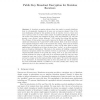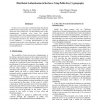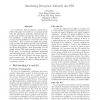111
click to vote
CRYPTO
1993
Springer
15 years 4 months ago
1993
Springer
A broadcast encryption scheme allows the sender to securely distribute data to a dynamically changing set of users over an insecure channel. One of the most challenging settings fo...
178
Voted
NDSS
1997
IEEE
15 years 5 months ago
1997
IEEE
In this work we describe a method for fully distributed authentication using public key cryptography within the Kerberos ticket framework. By distributing most of the authenticati...
107
click to vote
AGENTS
1998
Springer
15 years 5 months ago
1998
Springer
Certificate management infrastructure, a.k.a. PKI (Public Key Infrastructure), which issues and provides access to public key certificates to preserve the integrity of a public ke...
102
Voted
ACISP
1998
Springer
15 years 5 months ago
1998
Springer
PKI Public Key Infrastructure is fundamental for many security applications on the network. However, there are so many di erent kinds of PKI at current stage and they are not comp...
104
click to vote
IH
1999
Springer
15 years 5 months ago
1999
Springer
The new watermarking technique1 presented in this paper is an example of an asymmetric public detection scheme. The detection process does not need the original picture nor the sec...
83
Voted
SIGUCCS
1999
ACM
15 years 5 months ago
1999
ACM
This paper attempts to illuminate several fundamental concepts used in the creation of a Public Key Infrastructure (PKI). These concepts include encryption, public key cryptograph...
89
Voted
ACSAC
1999
IEEE
15 years 5 months ago
1999
IEEE
Mainly for scalability reasons, many cryptographic security protocols make use of public key cryptography and require the existence of a corresponding public key infrastructure (P...
92
Voted
CRYPTO
2000
Springer
15 years 5 months ago
2000
Springer
We present a chosen-ciphertext attack against the public key cryptosystem called NTRU. This cryptosystem is based on polynomial algebra. Its security comes from the interaction of ...
ACSAC
2000
IEEE
15 years 5 months ago
2000
IEEE
It is well-known that CA plays the central role in PKI. In this paper we introduce a new component into PKI, DA (decryption authority), which decrypts important and sensitive mess...
84
Voted
IMA
2001
Springer
15 years 5 months ago
2001
Springer
We present a novel public key cryptosystem in which the public key of a subscriber can be chosen to be a publicly known value, such as his identity. We discuss the security of the ...






